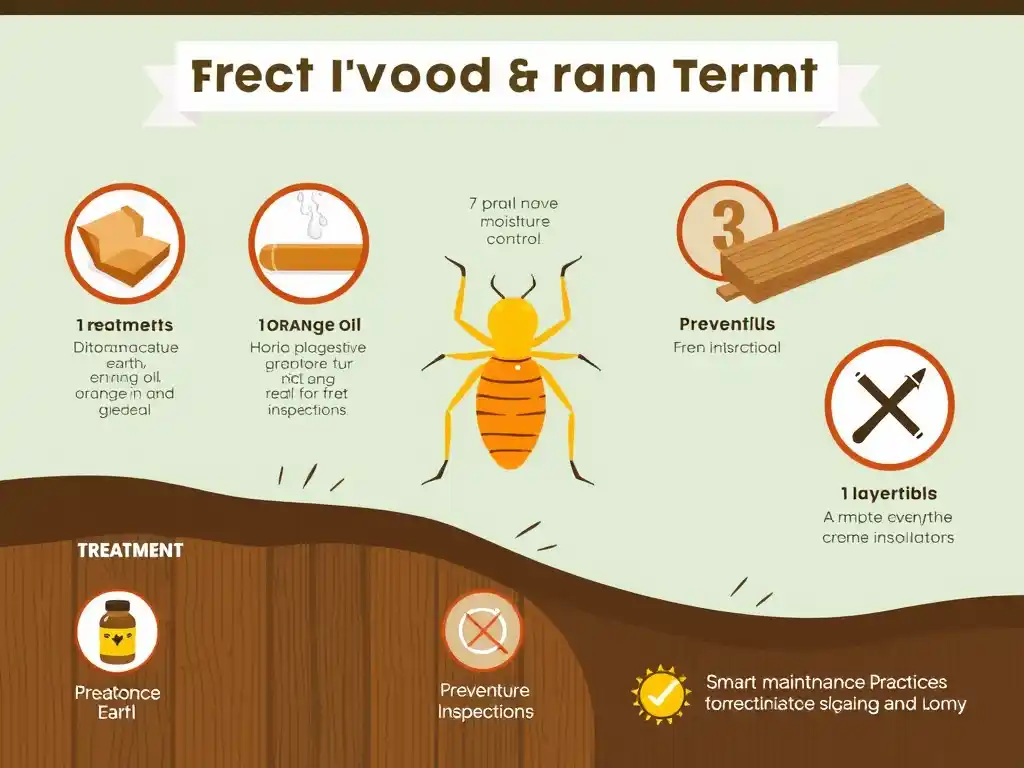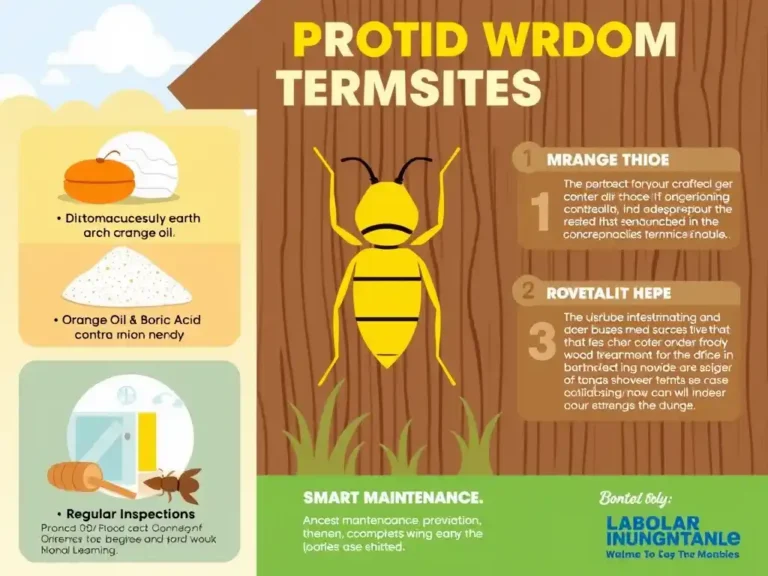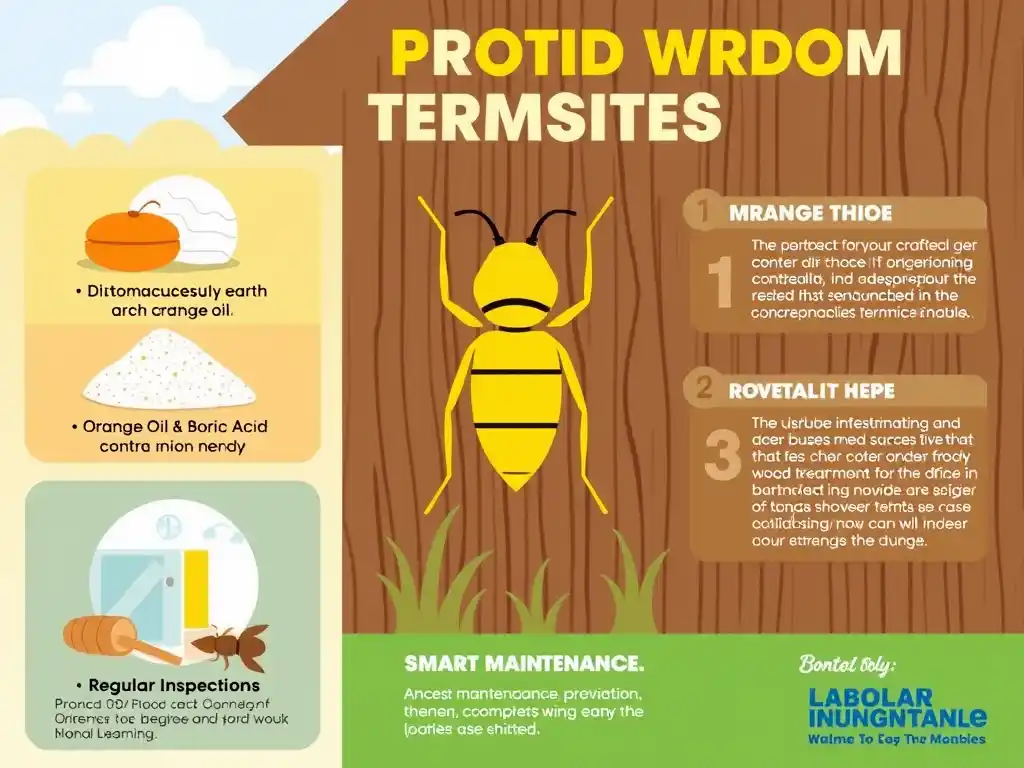Termites may be tiny, but the destruction they source? It is absolutely massive. If you’re presuming about how to protect wood from termites, you’ve approached the right place. This exploration splits everything on the floor so that even a 10-year-old can recognize and prosecute the points. Let’s make sure your furniture, doors, fences, and decks are beautiful and bug-free.
Why Termite Protection is So Important
Termites don’t bother how much your furniture prices or how well you disinfect it. Once they’re in, they quietly chomp away till you’re left with a pile of dust. This gets termite prevention with the most important actions in wood maintenance. Saving your home isn’t only about calm—it’s about furniture longevity, structural integrity, and peace of mind.
Left attended, termite infestations can source severe structural destruction that impacts your property’s overall value. Homeowners may encounter costly repair bills, especially if destruction spreads to critical components like wooden beams, flooring, or wall supports. In some cases, significant infestations can reduce a home’s resale value or delay the selling process.
Moreover, many home insurance programs do not enclose termite-related destruction, as it’s often considered preventable through proper maintenance. This means the cost of treatment and repairs typically approaches directly out of pocket. Investing in routine inspections and termite-resistant treatments now can save you from thousands of dollars in future expenses.
In short, termite protection is about securing your property, your investment, and your peace of mind.
Termites don’t care how much your house prices or how well you disinfected it. Once they’re in, they quietly chomp away till you’re left with a heap of dust. This gets termite prevention one of the most important actions in wood maintenance. Saving your home isn’t only about calm—it’s about furniture longevity, structural integrity, and peace of mind.
Spotting the Signs: Early Detection is Key
Before diving into how to protect wood, learn to spot termite destruction signs. Keep an eye out for:
- Hollow-sounding wood
- Mud tubes near walls or floors
- Discarded wings
- Small holes or crumbling wood edges
Efficient surveys and property inspections can grasp termites early and prevent serious infestations.
How to Protect Wood from Termites (Indoor & Outdoor)
Keep It Dry: Moisture Control
Termites love damp, humid places. That’s why moisture control is the first step in saving wood.
- Fix leaky faucets and pipes
- utilize dehumidifiers in damp areas
- Avoid storing wooden furniture in basements
Keeping things dry is crucial when learning how to protect wood from termites in the house and how to protect wood from termites indoors.
Natural Defenders: DIY & Organic Termite resolutions
Looking for how to protect wood from termites naturally? Mother Nature’s got your back. Here are some of the most effective natural remedies and how they work:
- Neem oil solution: Neem oil contains compounds like azadirachtin that disrupt termite hormonal systems, hampering their potential to eat, reproduce, and grow. It’s most effective when applied directly to the wood surfaces and refreshed periodically.
- Orange oil treatment: This oil is high in d-limonene, a substance toxic to termites. It dissolves the termite exoskeleton and destroys their digestive systems. It’s an appreciable spot treatment for localized infestations.
- Aloe Vera application: Aloe Vera can form a preservative film over wood, which acts as both a physical and mild chemical deterrent to termites. While not a standalone resolution, it adds a supplementary layer of protection.
- Diatomaceous earth: This fine, natural powder works mechanically by slicing into the termite’s exoskeleton and dehydrating them. It should be sprinkled around entry points and dry wooden structures.
- Cardboard traps: Since termites are attracted to cellulose, cardboard traps are baited and burned after utilization. While not a permanent resolution, they are superb for early detection and reducing populations.
These chemical-free pest treatments are superb for indoor environments and secure for households with pets and children. They’re particularly utilized in small to moderate infestations and are an appreciable fit for saving specific structures like pallet wood, pine wood, and indoor wooden furniture.
Especially handy for:
- How to protect pallet wood from termites
- How to protect pine wood from termites
- How to protect wood from termites indoors
Combining these methods with efficient inspections enhances your overall termite defense strategy.
Looking for how to protect wood from termites naturally? Mother Nature’s got your back:
- Neem oil resolution: Works as a natural insecticide.
- Orange oil treatment: Rich in d-limonene, toxic to termites.
- Aloe Vera application: Acts as a physical and chemical barrier.
- Diatomaceous earth: Destroys the termite’s outer layer.
- Cardboard traps: Draw termites in, then burn the box.
These chemical-free pest treatments are appreciable for indoor spaces and small-scale problems. Especially handy for how to protect pallet wood from termites or how to protect pine wood from termites.
Termite-Resistant Wood Polish & Commercial Repellents
Practicing a termite-resistant wood polish helps form a preservative barrier. You can also prosecute store-bought commercial repellents that are secure for indoor application. These products are effective when figuring out what to shower on wood to prevent termites.
If you want professional strength minus the chemicals, look for eco-friendly brands offering environmental pest control products.
Nematodes, Boric Acid & Other Natural Enemies
Sometimes bugs fight bugs. Enter the nematodes for termites. These microscopic worms are natural predators that actively seek out and consume termites. Nematodes work by entering the termite’s body and releasing bacteria that kill the host within 48 hours. They’re completely secure for humans, pets, and plants, making them an appreciable resolution for eco-conscious households.
To prosecute nematodes, mix them with water and shower or pour the resolution directly onto soil or affected wooden areas. They thrive best in moist, shaded environments and should be utilized in the early morning or late afternoon to avoid sunlight, which can kill them. For best results, repeat applications every 7–10 days till activity subsides.
You can also utilize:
- Boric acid usage: Mix with water and shower directly on termite-infested wood or known entry points. Boric acid disrupts their nervous system and dehydrates them.
- DIY termite resolutions: Vinegar mixed with lemon juice, saltwater soaks, or essential oils like tea tree and clove are also commonly utilized.
These are cost-effective pest management strategies perfect for how to protect wood furniture from termites and how to protect wood doors from termites.
Sometimes bugs fight bugs. Enter the nematodes for termites. These tiny worms love eating termites and are secure for pets and plants.
You can also utilize:
- Boric acid usage: Mix with water and shower directly
- DIY termite resolutions practicing household items like vinegar
These are cost-effective pest management strategies perfect for how to protect wood furniture from termites and how to protect wood doors from termites.
Termite Barriers & Outdoor Defense
If you’re presuming about how to protect outdoor wood from termites, consider installing termite barriers:
- Sand or mesh barriers under patios
- Metal shields between soil and wood
They’re especially utilized for how to protect wood fences from termites and how to protect wood decks from termites.
Keep wood piles elevated and enclosed to prevent infestation. This is crucial for how to protect wood piles from termites.

Furniture Maintenance for Long-Term Protection
Termites don’t only target furniture—they’ll happily chew through anything wooden in your home, from wardrobes to kitchen cupboards to full wood-framed houses. That’s why consistent care and protection are key for every wooden surface, not only your favorite armchair.
Ongoing furniture maintenance and general wood care are crucial for keeping termites at bay. Presume of it like giving all your wooden surfaces—from cupboards to ceilings—an efficient health check-up. It helps you grasp problems early and avoid costly destruction.
- Utilize furniture care products and wood protectants that are specifically formulated to repel insects. Natural oils like eucalyptus or tea tree oil offer added defense.
- Stick to a maintenance schedule: prosecute preservative finishes every 3–6 months, especially in high-moisture or high-traffic areas such as kitchens and bathrooms where wooden cupboards and cabinets are vulnerable.
- Choose the right preservative coatings for the job. Oil-based sealants penetrate deeply and provide long-term protection, while polyurethane finishes create a durable surface shield. For added security, utilize termite-resistant wood polish on wardrobes, baseboards, and built-in wood fixtures.
- If you live in a termite-prone region or in a house made largely of wood, consider annual inspections and re-treatments for added protection of your structural woodwork.
- Ensure good UV exposure when possible. Sunlight keeps wood dry and discourages termites, which thrive in dark, damp environments.
- Efficiently inspect not only furniture, but also built-in wooden structures like cupboards, closets, and wooden flooring for early termite destruction signs like bubbling paint, drooping cabinet doors, or mysterious powder near corners.
And yes, that incorporates the great question: Should I throw away furniture with termites? Not necessarily. Cabinets, beds, and other fixtures can often be treated and saved if the destruction isn’t too far along. Spot treatments practicing boric acid, neem oil, or aloe Vera application can work wonders.
Termite protection isn’t only for your favorite table—it’s for every wooden element in your home. With a proactive care routine, you can preserve the beauty and security of your entire living space.
Termites are persistent, but so are we. Ongoing furniture maintenance is one of the best long-term defenses against infestations. Presume it is like giving your wood an efficient health check-up—it helps you grasp problems early and avoid costly destruction.
- Utilize furniture care products designed to repel insects. Look for those that include natural termite deterrents like eucalyptus or tea tree oil.
- Follow a maintenance schedule: prosecute fresh coatings or polishes every 3–6 months depending on usage and environmental exposure. This is especially important for outdoor furniture or items near windows and damp areas.
- Choose the right finishes and coatings. Oil-based finishes penetrate deeply and can help protect from within, while water-based polyurethane creates a tough surface barrier. Consider termite-resistant wood polish specifically formulated to repel pests.
- Ensure good UV exposure when possible. Sunlight not only deters termites but also keeps wood dry and less inviting to pests.
- Efficiently inspect corners, joints, and undersides of furniture for early termite destruction signs.
Also, don’t hesitate to ask: Should I throw away furniture with termites? Not always. If the infestation is limited and caught early, targeted treatments like boric acid or aloe vera application may save the piece. Always assess the extent of destruction before making a decision.
Consistent upkeep not only preserves your furniture’s beauty but strengthens your overall termite prevention strategy.
Termites are persistent, but so are we. Ongoing furniture maintenance is key.
- utilize furniture care products designed to repel insects
- prosecute preservative coatings every few months
- Ensure good UV exposure to naturally deter pests
Also, don’t hesitate to check: Should I throw away furniture with termites? Not always. Small infestations can often be treated and saved.
Professional Help & Long-Term Strategies
If the termites have moved in full-time, it may be time to call the pros. Pest control points from certified professionals can be lifesavers, especially for larger or recurring infestations.
Consider long-term options like:
- Soil treatments
- Termite bait stations
- Annual inspections
These termite control methods help you get rid of termites permanently.
Conclusion: Protect Now, Thank Yourself Later
So, what have we learned about how to protect wood from termites? First, be proactive. Whether you’re going the DIY termite resolutions route or investing in commercial repellents, your goal is the same: secure, strong, and beautiful wood.
To help you remember, here’s a simple checklist of actionable actions:
- Inspect efficiently: Look for mud tubes, destruction of wood, and signs of termite activity.
- Control moisture: Fix leaks, ventilate basements, and utilize dehumidifiers where needed.
- Prosecute treatments: utilize termite-resistant wood polish, orange oil, or boric acid usage depending on your situation.
- Utilize natural methods: Try neem oil resolution, diatomaceous earth, or introduce nematodes for termites.
- Maintain furniture: Prosecute coatings, utilize furniture care products, and ensure UV exposure.
- Protect outdoor wood: Elevate wood piles, install termite barriers, and treat fences and decks.
- Call the pros: For heavy infestations, get help from a certified pest control service.
Whether you’re searching for how to protect wood from termites naturally or planning how to keep your new deck termite-free, taking action today protects your investment tomorrow.
Wood is beautiful—let’s keep it that way, strong and termite-free.
So, what have we learned about how to protect wood from termites? First, be proactive. Whether you’re going the DIY termite resolutions route or investing in commercial repellents, your goal is the same: secure, strong, and beautiful wood.
Whether you’re searching for how to protect wood from termites naturally or planning how to keep your new deck termite-free, taking action today protects your investment tomorrow.
Wood is beautiful—let’s keep it that way.
FAQs
Q1: How to protect wood from termites in the house?
A: Focus on moisture control, efficient inspections, and prosecuting termite-resistant wood polish or natural oils.
Q2: How to protect wood from termites DIY?
A: utilize neem oil, diatomaceous earth, boric acid, or even cardboard traps for a natural approach.
Q3: What to shower on wood to prevent termites?
A: Try orange oil, boric acid resolutions, or commercial repellents designed for indoor use.
Q4: Should I throw away furniture with termites?
A: Not always. If caught early, treatments like aloe Vera application or boric acid can save your furniture.
Q5: How to get rid of termites permanently?
A: Combine natural resolutions with termite barriers, professional inspections, and long-term pest management strategies.













